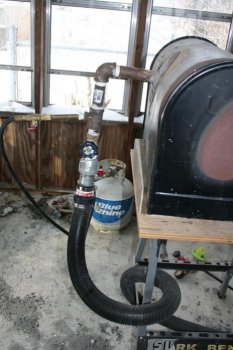RangerMadeKnives
KNIFE MAKER
Not too long ago I asked about buying an Atlas Mini Forge. One thing lead to another and here I am about to build a blown forge as my first forge. I received several components from Bruce Bump and I've begun purchasing/scrounging everything else. I ordered and have received a 60cfm blower and my ITC100 came in today. I already had plenty of Satanite on hand. I still need to find some material for the body which will likely be 12" pipe but, I am considering a 20lb propane tank as well.
Get ready, I'm going to ask a lot of questions. I'm just not a fan of being blown up. I've done a lot of research and have found an abundance of information on naturally aspirated venturi type burners but, very little on forced air setups. From what I can tell, there is no jet on the blown burners but rather, an inlet tube. How does the placement of the gas inlet affect the combustion of the mixture? How far does the gas inlet need to be away from the end of the burner tube? Why is the end of the tube flared? I understand that the metal portions of the burner tube will melt if they extend into the forge but, how far recessed should they be? Where will my flame sit in relation to the end of the burner tube? I'm probably going to need someone to get very basic with me on this.
Bob
Get ready, I'm going to ask a lot of questions. I'm just not a fan of being blown up. I've done a lot of research and have found an abundance of information on naturally aspirated venturi type burners but, very little on forced air setups. From what I can tell, there is no jet on the blown burners but rather, an inlet tube. How does the placement of the gas inlet affect the combustion of the mixture? How far does the gas inlet need to be away from the end of the burner tube? Why is the end of the tube flared? I understand that the metal portions of the burner tube will melt if they extend into the forge but, how far recessed should they be? Where will my flame sit in relation to the end of the burner tube? I'm probably going to need someone to get very basic with me on this.
Bob



